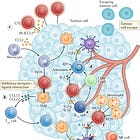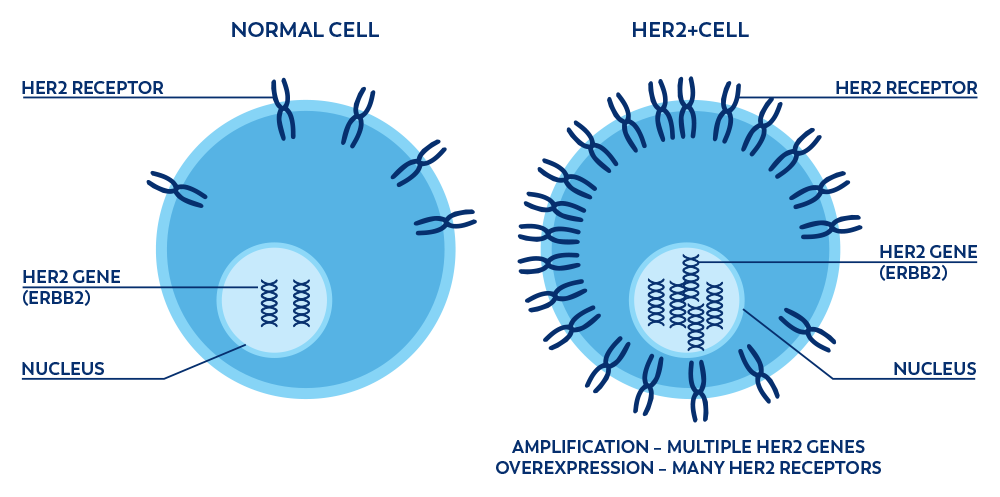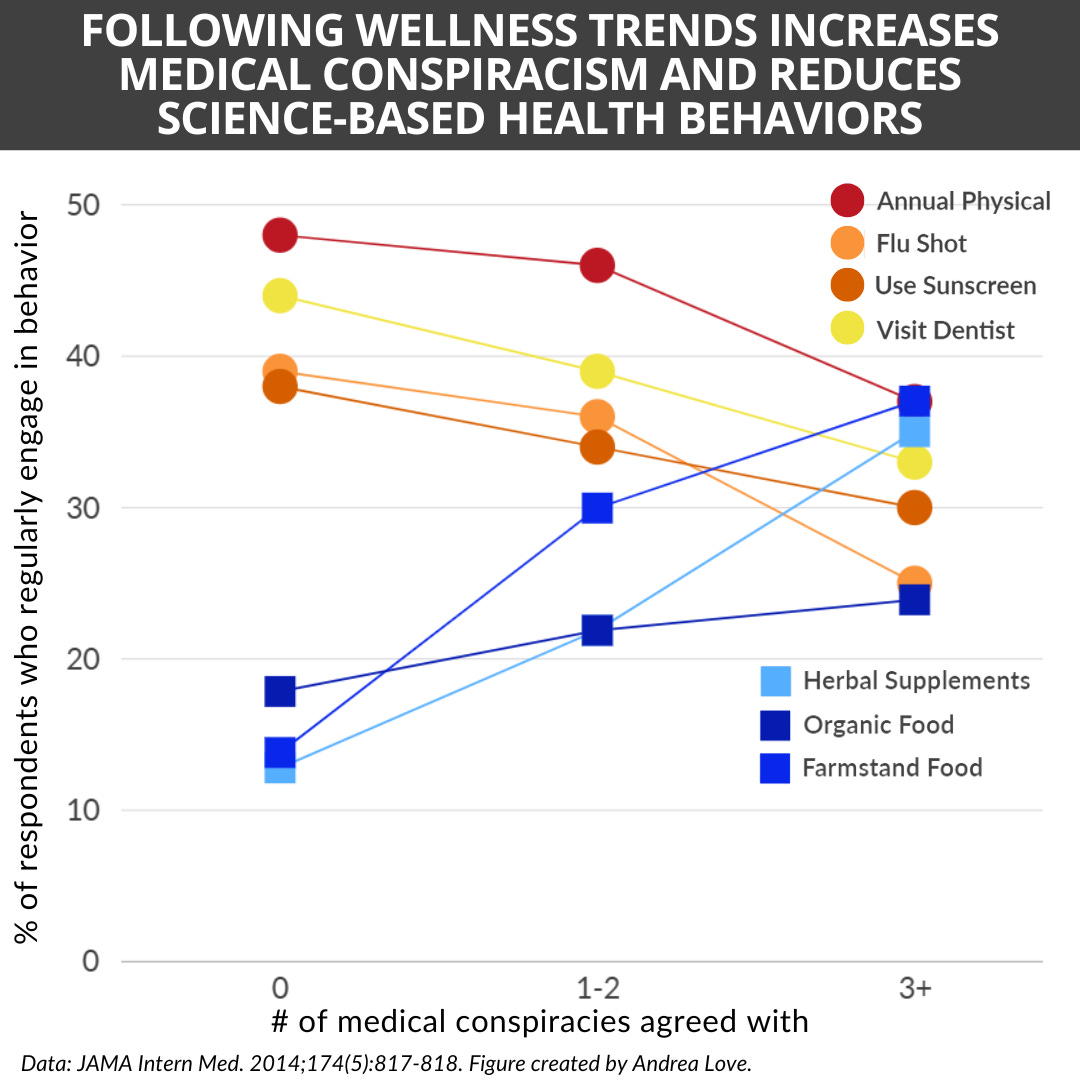Cancer misinformation kills. Chemotherapy saves lives.
Rejecting evidence-based treatment in favor of false hope and wellness industry lies is deadly.
This newsletter is free, but it’s able to sustain itself from support I receive from a small percentage of regular readers. If you value science-based information, consider upgrading to a paid subscription:
Note: a slightly different version of this is originally published in the May/June 2025 edition of Skeptical Inquirer magazine for my column, Inside Immunity.
As an immunologist who works in biomedical research, I know misinformation and pseudoscience about cancer is not only frustrating but also extremely dangerous. And if any of you watched the recent Netflix series Apple Cider Vinegar, let me tell you: that is only scratching the surface of dangerous lies that circulate in wellness spheres.
One of the most pervasive—and deadly—myths about cancer is that chemotherapy kills more people than cancer itself would.
This anti-chemo rhetoric is popular among wellness influencers, medical conspiracists, and alternative practitioners. These individuals promote the lie that chemotherapy is a scam and a poison created by “Big Pharma” and pushed by doctors for profit while hiding the natural cures for cancer. Even though we have decades of data that shows this is false, this narrative continues to be spread by those who profit off it.
What even is chemotherapy, anyway?
Like nearly all pseudoscience, the myth that “chemo kills more than it saves” has a nugget of reality baked within it. Some of that is based on fundamental misunderstanding of cancer and chemotherapy.
Cancer is a term that represents hundreds of different diseases, with nearly 200 different types of cancers currently categorized. But even within those types, every single cancer is going to be genetically unique to the patient, because cancer occurs when our own cells stop responding to the growth and regulatory signals within our body and start to uncontrollably reproduce.
Cancers all share certain hallmarks, but every cancer is distinct. One person’s breast cancer is not identical to another person’s breast cancer. In cancer, cells stop behaving like the cells they started from, allowing cancer cells to ignore signals telling them to stop dividing or die. This allows them to extend their life span, grow uncontrollably, and grow in places they don’t belong.
Chemotherapy is a catch-all term representing chemical compounds that interfere with these growth processes. The challenge is that cancer cells are your own cells—just ones that have mutations that cause them to misbehave. As a result, chemotherapy medications will also affect healthy cells, but the goal is for chemotherapy to target cancerous cells faster than healthy cells—to eliminate the cancer while minimizing the side effects.
Chemotherapies include many different categories of medications: some damage the genetic material in cells and prevent them from reproducing; some mimic natural building blocks of cellular molecules to interfere with cell division; others block enzymes required to replicate DNA—an essential step in cell division; some block structural proteins that are required for the physical cell division process (called mitosis). Ultimately, these chemicals accomplish similar goals: to interfere with the processes by which cancer cells grow and spread.
These chemotherapies unavoidably also attack healthy cells. This is the reason chemotherapies can have side effects. This is why people experience symptoms such as nausea or hair loss when undergoing some types of chemotherapy; the rapidly dividing cells of your stomach and hair follicles are also victims of chemotherapy. But it is important to understand this trade-off: the risk of dying without treatment is far greater. That math is part of the review for any FDA-approved medication, and in the case of cancer, that math is going to be different compared to something such as hypertension.
We have had immense improvements in cancer outcomes over the past sixty years, thanks in large part to chemotherapies.
Acute lymphoblastic leukemia (ALL) is a blood cancer where immature white blood cells grow out of control. ALL is the most common pediatric cancer, accounting for 25 percent of all pediatric cancers. ALL particularly affects young children, with 75 percent of cases occurring in children under six (National Cancer Institute 2025b). In the 1960s, the survival rate for ALL was 10 percent. Today it is over 90 percent because of chemotherapies such as vincristine (Demidowicz et al. 2019; Sasaki et al. 2021; Hunger et al. 2012).
Hodgkin’s lymphoma is a blood cancer where specific white blood cells, lymphocytes (memory immune cells) grow out of control. It is characterized by the presence of a specific type of cell, Reed-Sternberg cells, which differentiates it from non-Hodgkin’s lymphoma. In the 1970s, Hodgkin’s lymphoma had a survival rate of around 56 percent. Today, it has a survival rate of 87 percent because of chemotherapies (Hannuksela et al. 2024; Borchman et al. 2012).
Testicular cancer was fatal in nearly 95 percent of cases before the development of the chemotherapy cisplatin in the 1970s. Today, as a result of chemotherapeutics, survival exceeds 95 percent, even when cancer has metastasized (spread to other regions of the body) (National Cancer Institute 2025a; Einhorn 2002).
HER2-positive breast cancer is characterized by overexpression of the protein HER2. Regular expression of HER2 leads to normal growth, but overexpression leads to excess cell growth and more aggressive cancer.
Previously, HER2-positive breast cancer patients had a five-year survival rate of 68 percent compared to 96 percent for HER2-negative breast cancer patients (Tovey et al. 2009). Today, with chemotherapy and HER2-targeted medications, survival for HER2-positive breast cancer approaches that of HER2-negative breast cancer (Bradley et al. 2021).
These improvements and others aren’t accidental; they are the direct result of decades of scientific research, therapeutic development, and rigorous clinical trials all conducted by people who have devoted their lives to solving the mysteries of cancer.
Wellness disinformation causes needless suffering and death
No matter the cancer, prompt intervention after detection is critical to improve survival. The longer a cancer can progress without intervention, the higher the chances are that cancer grows or spreads in a way that makes treatments less effective. When cancer patients refuse chemotherapy and other supported treatments and instead use “alternative treatments,” survival rates plummet.
Studies of the use of alternative medicine for cancer have shown that patients who refuse conventional treatments and rely on unsupported therapies die more often and faster. One such study looked at several different cancers:
Breast cancer patients who rejected chemotherapy had a 5.68-fold higher risk of death. Five-year survival dropped from 86.6 percent to 58.1 percent.
Patients with colorectal cancer had a 4.57-fold increased risk of death, and five-year survival plummeted from 79.4 percent to 32.7 percent.
Patients with lung cancer had a 2.17-fold increased risk of death, with five-year survival declining from 41.3 percent to 19.9 percent (Johnson et al. 2018).
These are not trivial differences. It’s the difference between life and death for many of these people.
The wellness industry thrives on distrust of medicine, pushing the false claims that the “real” cancer cures are being suppressed because doctors want to keep patients sick by poisoning them with chemotherapy for money. This medical conspiracism is the foundation of the wellness industry’s business model.
If you convince people that science-based medicine and credible healthcare providers are the villain, you can get them to opt in to the alternatives you’re promoting. One study showed that as the number of medical conspiracies someone believed in increased, so did the number of “wellness” behaviors, such as taking herbal and dietary supplements and buying organic foods (Oliver and Wood 2014). More concerning, this was paired with a decline in participating in evidence-based measures: wearing sunscreen, going to the dentist, getting an annual physical, and getting flu shots. You know—things that actually improve health outcomes (Love and Suleta 2024).
The number one conspiracy that respondents believed is that the government is hiding “natural cures for cancer,” a belief that costs people their lives. Patients who opt for alternative treatments are also less likely to use conventional treatments in conjunction (Johnson et al. 2018). Thirty-four percent of patients receiving alternative treatments refused any sort of chemotherapeutic, compared to 3 percent of patients receiving other conventional treatments. This delays supported treatments until cancer progression limits effective treatment options and increases risk of death.
Who Chooses Alternative Cancer Treatments?
Patients who opt for alternative cancer treatments tend to be younger, White, female, more affluent, and moderately—but not highly—educated. Sounds like the target demographic for the growing wellness industry, right?
Wellness products advertised to treat cancer are the same as those hawked to improve immunity, longevity, hormones, metabolism, and more (Miller et al. 1998; Clarke et al. 2015). These include alkaline diets, dietary supplements (including intravenous vitamin C, herbal remedies, megadose vitamins, “detox” blends), homeopathy, chiropractic, ozone therapy, coffee enemas, rigid dietary interventions, and more (Gorski 2015). Not only do these have no evidence to support their use, but many pose serious risks, especially to cancer patients (U.S. Food and Drug Administration 2020).
The hypocrisy of it all is that the wellness industry is an unregulated $6.3 trillion-dollar global industry—with very little supporting evidence. Perhaps it needs to be more widely known that the dietary supplement industry is valued at $177.5 billion dollars and has no quality, safety, or efficacy oversight.
The wellness industry is not actually concerned with wellness.
If they were, they wouldn’t be selling unsupported and untested interventions that cause people to die. While they rail against the supposed greed of Big Pharma, they have no problem charging desperate patients thousands of dollars for useless (and often dangerous) treatments. “Follow the money” indeed!
No one is hiding ‘natural’ cures: many cancer drugs start with natural compounds
While many of these individuals promote “natural” remedies for cancer while undermining science-based treatments, they ignore (or perhaps are ignorant of) the fact that many of our supported cancer treatments are derived from natural chemicals.
Docetaxel is a synthetic derivative of paclitaxel, a chemical from the Pacific yew tree that has been chemically altered to improve its effectiveness, reduce side effects, and enable its use in more cancer types (Love 2025).
Topotecan is a derivative of camptothecin, a chemical isolated from the Chinese happy tree. The chemical modifications make it safer, more bioavailable, more effective against a broader range of cancers, and reduces side effects (Love 2025).
Our ability to harness nature and improve on it with our scientific knowledge and biotechnologies has led to incredible scientific innovations we have today. These innovations—not your local influencer’s green smoothie—are saving the lives of those with cancer.
read more on this, below:
No one is hiding cures for cancer: many cancer drugs start with natural compounds
Spoiler: many of our effective cancer chemotherapeutics are derived from natural sources.
If there were natural chemicals that showed potential for cancer treatments, scientists would (and have) studied it. And guess what: we have.
It’s long past the time for “politeness” on these topics. Health misinformation is a threat to public health, especially when it comes to cancer, a category of diseases that are already poorly understood and incredibly difficult to treat. If you have cancer, you need real medicine.
Chemotherapy is tough, but it works. People telling you otherwise?
They’re lying to you—and they’re profiting while they do it.
Now, more than ever, we all must join in the fight for science.
Thank you for supporting evidence-based science communication. With outbreaks of preventable diseases, refusal of evidence-based medical interventions, propagation of pseudoscience by prominent public “personalities”, it’s needed now more than ever.
More science education, less disinformation.
- Andrea
ImmunoLogic is written by Dr. Andrea Love, PhD - immunologist and microbiologist. She works full-time in life sciences biotech and has had a lifelong passion for closing the science literacy gap and combating pseudoscience and health misinformation as far back as her childhood. This newsletter and her science communication on her social media pages are born from that passion. Follow on Instagram, Threads, Twitter, and Facebook, or support the newsletter by subscribing below:
References
Borchmann, Peter, Dennis Eichenauer, and Andreas Engert. 2012. State of the art in the treatment of Hodgkin lymphoma. Nature Reviews Clinical Oncology 9: 450–459.
Bradley, Rosie, et al. 2021. Trastuzumab for early-stage, HER2-Positive breast cancer: A meta-analysis of 13,864 women in seven randomised trials. The Lancet Oncology 22(8): 1139–1150.
Clarke, Tainya, et al. 2015. Trends in the use of complementary health approaches among adults: United States, 2002–2012. National Health Statistics Reports 79: 1–16.
Demidowicz, Ewa, et al. 2019. Outcome of pediatric acute lymphoblastic leukemia: Sixty years of progress. Anticancer Research 39(9): 5203–5207.
Einhorn, Lawrence. 2002. Curing metastatic testicular cancer. Proceedings of the National Academy of Sciences 99(7): 4592–4595.
Gorski, David. 2015. The Gerson Protocol and the death of Jess Ainscough. Science-Based Medicine (March 2). Online at https://sciencebasedmedicine.org/the-gerson-protocol-and-the-death-of-jess-ainscough/.
Hannuksela, Noora, et al. 2024. Survival of patients with classical Hodgkin lymphoma in Finland: A national population-based analysis. Blood Cancer Journal 14: 139.
Hunger, Stephen, et al. 2012. Improved survival for children and adolescents with acute lymphoblastic leukemia between 1990 and 2005: A report from the children’s oncology group. Journal of Clinical Oncology 30(14): 1663–1669.
Johnson, Skyler, Henry Park, Cary Gross, et al. 2018. Use of alternative medicine for cancer and its impact on survival. Journal of the National Cancer Institute 110(1) (January): 121–124. Online at https://doi.org/10.1093/jnci/djx145.
Love, Andrea. 2025. No one is hiding cures for cancer: Many cancer drugs start with natural compounds. ImmunoLogic (January 14).
Love, Andrea, and Katie Suleta. 2024. Is wellness bad news for healthcare? The growing industry is a double-edged sword. MedPage Today (September 2).
Miller, Megan, et al. 1998. The use of unproven methods of treatment by cancer patients. Supportive Care in Cancer 6: 337–347.
National Cancer Institute. 2025a. Stat facts: Cancer of the testis. Surveillance, Epidemiology, and End Results Program: SEER Cancer Surveillance Research Program.
2025b. Stat facts: Childhood leukemia (ages 0–19). Surveillance, Epidemiology, and End Results Program. SEER Cancer Surveillance Research Program.
Oliver, J. Erik, and Thomas Wood. 2014. Medical conspiracy theories and health behaviors in the United States. JAMA Internal Medicine 174(5): 817–818.
Sasaki, Koji, et al. 2021. Acute lymphoblastic leukemia: A population-based study of outcome in the United States based on the surveillance, epidemiology, and end results (SEER) database, 1980–2017. American Journal of Hematology 96(6): 650–658.
Tovey, S.M., et al. 2009. Poor survival outcomes in HER2-positive breast cancer patients with low-grade, node-negative tumours. British Journal of Cancer 100(5): 680–683.
U.S. Food and Drug Administration. 2020. Products claiming to cure cancer are a cruel deception.









This was excellent! The simplistic nature of our collective thinking is so frustrating!
I’m in a position that doesn’t allow me to speak directly to misconceptions (I’m a psychologist, not a scientist), but I can gently question people about absurd (in my opinion) generalizations. Here are some of my favs: 1) using the term “big pharma”’as an insult, implying that all pharmaceutical companies are totally nefarious, making money without any interest in helping find treatments to problems. 2) “detox” and related diets that completely neglect the fact that, if organs such as your liver are working properly, they will take care of this for you. 3) the idea that cancer is cancer is cancer - therefore, a friend’s successful experience will apply to you. 4) “I don’t really believe in western medicine,” uttered by people with no scientific training. 5) that the way to avoid getting sick is to take large amounts of supplements. (“I take zinc and vitamin C before I travel and I never get sick.” Well, that sounds like a solid, scientific study.🙄) Thankfully, when I mention my skepticism about supplements to my PCP and his PA, they both just laugh and say, “well, if that’s what people want to throw their money away on, I guess that’s their decision.”
Again, thank you for your thorough - and thoroughly sane - approach during a very frightening time.
Dr Love,
An NPR program, Here & Now, WBUR, Boston interviewed a couple of trump voters (a man & a woman) today (4/30) and I heard the common tropes you hear from his supporters and also the misinformation one hears from the conspiracy theories. The lady, who stated she’s a hospital administrator stated unequivocally that if you believe that “Medicine” and “Big Pharma”wanted to cure cancer you are misinformed, cancer is about making money. She also stated Kennedy was doing a good job. Whew! Both guests shared a few facts mixed in with baseless repetitions of claims and declarations being made by the administration. Your essay was timely and insightful.